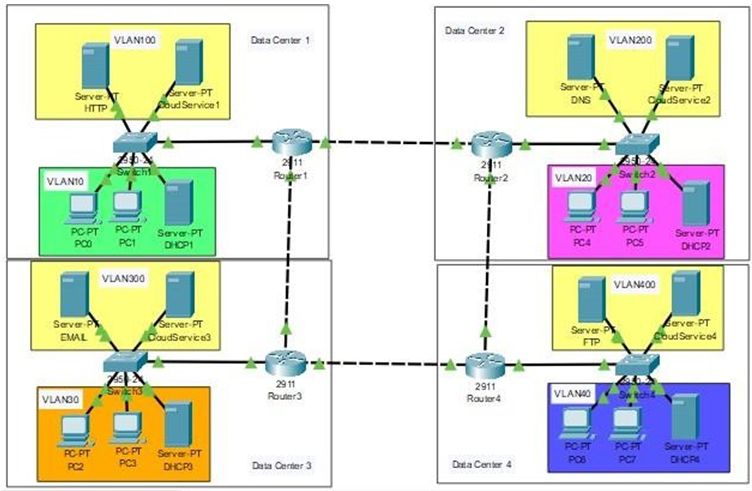High Availability Cloud Data Centre Network Simulation Using Cisco Packet Tracer This assignment aims at the design, simulation, and connectivity check of the network using Packet Tracer.
CSN6224 Computer Network Assignment Guidelines Trimester March 2025-26
| Category | Assignment | Subject | Computer Science |
|---|---|---|---|
| University | - | Module Title | CSN6224 Computer Network |
CSN6224 Assignment Guidelines
High Availability Cloud Data Centre Network Simulation Using Cisco Packet Tracer
This assignment aims at the design, simulation, and connectivity check of the network using Packet Tracer.
Your organisation manages four interconnected cloud data centres designed for high availability. Each data centre provides different cloud-based services, and network segmentation is achieved using VLANs. As network engineers, your group is responsible for designing, configuring, and simulating the full network infrastructure using Cisco Packet Tracer. Refer to the provided network diagram for logical layout and VLAN placement.

Guidelines/Instructions:
Each group must consist of a minimum of two (2) and a maximum of four (4) students.
Groups may form freely based on student choice.
The number of data centres in your network must correspond to the number of group members (e.g., 4 members = 4 data centres).
Each data centre must be assigned a unique IPv4 subnet address based on the birth date of a group member.
- For example, if a member was born on 28 May 2005, the assigned /24 subnet could be: 202.<day>.<month>.0, resulting in 202.28.5.0/24.
VLAN Assignment:
Public VLANs (for external service access):
- Data Centre 1: VLAN100
- Data Centre 2: VLAN200
- Data Centre 3: VLAN300
- Data Centre 4: VLAN400
Private VLANs (internal-only client access):
- Data Centre 1: VLAN10
- Data Centre 2: VLAN20
- Data Centre 3: VLAN30
- Data Centre 4: VLAN40
Each private VLAN must have its own DHCP server, and all PCs within the VLAN must obtain IP addresses dynamically.
All other servers (DNS, HTTP, Email, FTP) must be assigned static IPv4 addresses.
Services to be deployed as per the provided diagram:
- DNS
- HTTP (Web Server)
- Email (SMTP/POP3)
- FTP (File Transfer)
- Ensure all services are accessible publicly via the respective public VLANs.
Configure all routers using dynamic routing protocols such as RIP or OSPF.
Test full network functionality using:
- Ping between clients and servers across data centres
- Simulation Mode to verify packet flow and routing behaviour
Optional Enhancements (bonus marks):
- Add redundant links between routers for high availability and fault tolerance.
- Or any other improvement(s).
Submission Requirements:
Submit a Packet Tracer .pkt file and a PDF report via eBwise.
A PDF report (max 10 pages) containing:
- Cover page template
- IP Address Plan & Subnetting Table
- VLAN assignment table
- Configuration steps and screenshots
- Reflection and lessons learned
- Appendix 1 - Checklist and Evaluation Form
- Appendix 2 - Task Distribution
- Appendix 3 - Self-Peer Evaluation Form
Deadline: Saturday, 22 June 2025, 11:59 PM
Do You Need CSN6224 Assignment for This Question
Order Non-Plagiarised Assignment
Presentation Schedule:
- Presentations (10-15 minutes) will be conducted during Monday to Friday, 23–27 June 2025.
- Exact time slots will be announced by your lecturer.
Marking Scheme (Total: 100 marks)
Section | Marks |
1. Accurate VLAN Configuration | 15 |
2. Classless Subnetting Design from | 15 |
3. Service Configuration (DNS, DHCP, etc.) | 20 |
4. Dynamic Routing (OSPF) | 15 |
5. Inter-data centre Connectivity | 10 |
6. Functional Packet Flow (Simulation) | 10 |
7. Report Completeness & Clarity | 10 |
8. Bonus Features (e.g., redundancy) | 5 |
9. Group Presentation | 10 |
